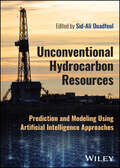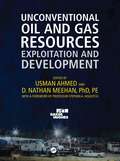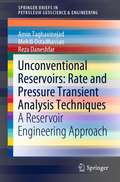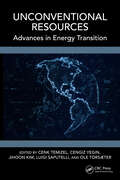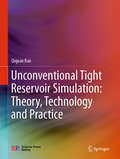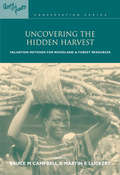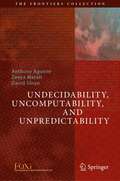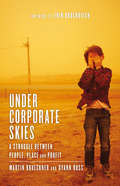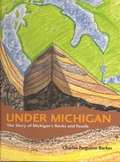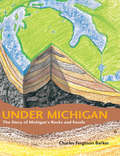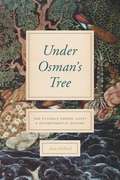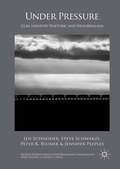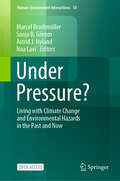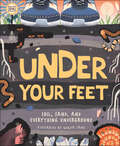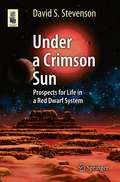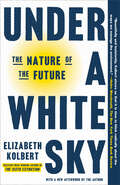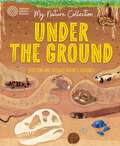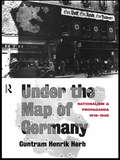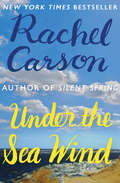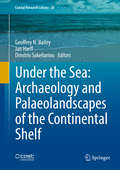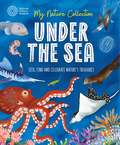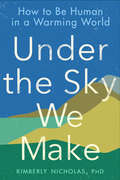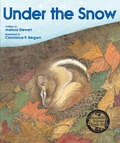- Table View
- List View
Unconventional Hydrocarbon Resources: Prediction and Modeling Using Artificial Intelligence Approaches
by Sid-Ali OuadfeulUnconventional Hydrocarbon Resources Enables readers to save time and effort in exploring and exploiting shale gas and other unconventional fossil fuels by making use of advanced predictive tools Unconventional Hydrocarbon Resources highlights novel concepts and techniques for the geophysical exploration of shale and other tight hydrocarbon reservoirs, focusing on artificial intelligence approaches for modeling and predicting key reservoir properties such as pore pressure, water saturation, and wellbore stability. Numerous application examples and case studies present real-life data from different unconventional hydrocarbon fields such as the Barnett Shale (USA), the Williston Basin (USA), and the Berkine Basin (Algeria). Unconventional Hydrocarbon Resources explores a wide range of reservoir properties, including modeling of the geomechanics of shale gas reservoirs, petrophysics analysis of shale and tight sand gas reservoirs, and prediction of hydraulic fracturing effects, fluid flow, and permeability. Sample topics covered in Unconventional Hydrocarbon Resources include: Calculation of petrophysical parameter curves for non-conventional reservoir modeling and characterization Comparison of the Levenberg-Marquardt and conjugate gradient learning methods for total organic carbon prediction in the Barnett shale gas reservoir Use of pore effective compressibility for quantitative evaluation of low resistive pays and identifying sweet spots in shale reservoirs Pre-drill pore pressure estimation in shale gas reservoirs using seismic genetic inversion Using well-log data to classify lithofacies of a shale gas reservoir Unconventional Hydrocarbon Resources is a valuable resource for researchers and professionals working on unconventional hydrocarbon exploration and in geoengineering projects.
Unconventional Oil and Gas Resources: Exploitation and Development (Emerging Trends and Technologies in Petroleum Engineering)
by Usman Ahmed D. Nathan MeehanAs the shale revolution continues in North America, unconventional resource markets are emerging on every continent. In the next eight to ten years, more than 100,000 wells and one- to two-million hydraulic fracturing stages could be executed, resulting in close to one trillion dollars in industry spending. This growth has prompted professionals ex
Unconventional Reservoirs: A Reservoir Engineering Approach (SpringerBriefs in Petroleum Geoscience & Engineering)
by Mehdi Ostadhassan Amin Taghavinejad Reza DaneshfarThis book provides a succinct overview on the application of rate and pressure transient analysis in unconventional petroleum reservoirs. It begins by introducing unconventional reservoirs, including production challenges, and continues to explore the potential benefits of rate and pressure analysis methods. Rate transient analysis (RTA) and pressure transient analysis (PTA) are techniques for evaluating petroleum reservoir properties such as permeability, original hydrocarbon in-place, and hydrocarbon recovery using dynamic data. The brief introduces, describes and classifies both techniques, focusing on the application to shale and tight reservoirs. Authors have used illustrations, schematic views, and mathematical formulations and code programs to clearly explain application of RTA and PTA in complex petroleum systems. This brief is of an interest to academics, reservoir engineers and graduate students.
Unconventional Resources: Advances in Energy Transition
by Jihoon Kim Luigi Saputelli Cenk Temizel Ole Torsæter Cengiz YeginThe oil and gas sector is a vital player in the energy transition. With their vast resource potential, unconventional shale plays will be an essential part in enabling this change. Unconventional Resources serves as a comprehensive reference covering the latest technologies, methodologies, and applications of unconventional shale resources in the oil and gas industry, and their role in the evolution of the sector's energy transition.This book: Offers an overview of geophysics, geology, and reservoir characterization in unconventional resources Discusses drilling, well stimulation and completion, production engineering, and artificial lift Covers reservoir management and surveillance, recovery enhancement, production forecasting, and surface facilities and testing Details technical and technological advances, including machine learning, AI, data analytics, and Industry 4.0 Explores the latest methods/workflows in performance analysis in unconventional plays Employs integrated and hybrid approaches to the energy transition The book provides surface and subsurface technical professionals in the oil and gas industry a thorough overview of unconventionals along with the integrated/hybrid applications that will enable them to stay current with the industry's transition.
Unconventional Shale Gas Exploration and Exploitation: Current Trends in Shale Gas Exploitation (Advances in Oil and Gas Exploration & Production)
by Shib Sankar Ganguli Annapurna Boruah Sumit VermaFrom the geological mysteries of shale formations to cutting-edge techniques in gas extraction, this book unveils the essential knowledge to harness the potential of shale gas. The book integrates various data types such as outcrop, well logs, core data, etc.) for hydrofracturing—from basin-scale to nano-pore-scale. The book included a wealth of information on the latest advancements, industry practices, environmental considerations, policies, and more. In a world increasingly conscious of environmental concerns, "Cleaner Energy from the Earth" offers a fresh perspective on the utilization of shale gas as a cleaner fossil fuel alternative. This comprehensive book takes the reader on a captivating journey through the science, technology, and innovation driving shale gas exploration and exploitation towards a greener future. Whether you're a seasoned industry professional, a student, or a curious reader, this book provides a comprehensive and accessible resource for all levels of expertise.
Unconventional Tight Reservoir Simulation: Theory, Technology and Practice
by Qiquan RanThis book systematically introduces readers to the simulation theory and techniques of multiple media for unconventional tight reservoirs. It summarizes the macro/microscopic heterogeneities; the features of multiscale multiple media; the characteristics of complex fluid properties; the occurrence state of continental tight oil and gas reservoirs in China; and the complex flow characteristics and coupled production mechanism under unconventional development patterns. It also discusses the simulation theory of multiple media for unconventional tight oil and gas reservoirs; mathematic model of flow through discontinuous multiple media; geological modeling of discrete multiscale multiple media; and the simulation of multiscale, multiphase flow regimes and multiple media. In addition to the practical application of simulation and software for unconventional tight oil and gas, it also explores the development trends and prospects of simulation technology. The book is of interest to scientific researchers and technicians engaged in the development of oil and gas reservoirs, and serves as a reference resource for advanced graduate students in fields related to petroleum.
Unconventional Water Resources
by Vladimir Smakhtin Manzoor Qadir Sasha Koo-Oshima Edeltraud GuentherThe world is faced with a growing number of complex and interconnected challenges. Water is among the top 5 global risks in terms of impacts, which would be far reaching beyond socio-economic challenges, impacting livelihoods and wellbeing of the people.As freshwater resources and population densities are unevenly distributed across the world, some regions and countries are already water scarce. Water scarcity is expected to intensify in regions like the Middle East and North Africa (MENA), which has 6% of the global population, but only 1% of the world’s freshwater resources. Climate change adds to this complexity as it is leading to rainfall uncertainty and extended droughts periods, mostly in arid areas.Increasing water scarcity is now recognized as a major cause of conflict, social unrest and migration and at the same time water is increasingly considered as an instrument for international cooperation to achieve sustainable development. Tapping and assessing sustainably every available option in water-scarce areas is needed as pressure continues to build on limited water resources.The stark fact is that conventional water provisioning approaches relying on snowfall, rainfall and river runoff are not enough to meet growing freshwater demand in water-scarce areas. Water-scarce countries need a radical re-think of water resource planning and management that includes the creative exploitation of a growing set of viable but unconventional water resources for food production, livelihoods, ecosystems, climate change adaption, and sustainable development. Unconventional water resources are generated as a by-product of specialized processes; need suitable pre-use treatment; require pertinent on-farm management when used for irrigation; or result from a special technology to collect/access water.
Uncovering the Hidden Harvest: Valuation Methods for Woodland and Forest Resources
by Martin K Luckert Bruce M CampbellForests and woodlands provide an enormous range of goods and services to society, from timber and firewood to medicinal plants, watershed protection, destinations for tourists and sacred sites. Only when these are understood and valued can forests and their resources be properly managed and conserved. This work shows how the complicated network of benefits can be untangled and sets out the different approaches needed to value them. It covers the analysis of plant-based markets, non-market valuation and decision frameworks such as cost-benefit analysis.
Undecidability, Uncomputability, and Unpredictability (The Frontiers Collection)
by Anthony Aguirre Zeeya Merali David SloanFor a brief time in history, it was possible to imagine that a sufficiently advanced intellect could, given sufficient time and resources, in principle understand how to mathematically prove everything that was true. They could discern what math corresponds to physical laws, and use those laws to predict anything that happens before it happens. That time has passed. Gödel’s undecidability results (the incompleteness theorems), Turing’s proof of non-computable values, the formulation of quantum theory, chaos, and other developments over the past century have shown that there are rigorous arguments limiting what we can prove, compute, and predict. While some connections between these results have come to light, many remain obscure, and the implications are unclear. Are there, for example, real consequences for physics — including quantum mechanics — of undecidability and non-computability? Are there implications for our understanding of the relations between agency, intelligence, mind, and the physical world? This book, based on the winning essays from the annual FQXi competition, contains ten explorations of Undecidability, Uncomputability, and Unpredictability. The contributions abound with connections, implications, and speculations while undertaking rigorous but bold and open-minded investigation of the meaning of these constraints for the physical world, and for us as humans.
Under Corporate Skies: A Struggle Between People, Place, and Profit
by Erin Brockovich Martin Brueckner Dyann RossRelating the story of a tiny town pitted against a strong corporation, this account strives to voice the concerns of local communities when they come into conflict with corporate profits. With the help of Erin Brockovich, the small town of Yarloop in Western Australia is fighting its powerful neighbor, Alcoa World Alumina. Their struggle is over social, health, and environmental concerns surrounding Alcoa’s Wagerup alumina refinery. The stories told here are shared by communities around the world amidst ongoing industrialization and resultant collisions between social and economic interests. Depicting life under corporate influence, this study explicitly illustrates that profits matter—but not more than people and place.
Under Michigan: The Story of Michigan's Rocks and Fossils
by Charles Ferguson BarkerMost people recognize Michigan by its mitten-shaped Lower Peninsula and the Great Lakes embracing the state. Underneath the earth's surface, however, is equally distinctive evidence of an exciting history. Michigan rests on sedimentary rocks that reach down into the earth's crust more than fourteen thousand feet-a depth three-and-a-half times deeper than the Grand Canyon. Within these layers of rock rest all sorts of ancient fossils and minerals that date back to the eras when tropical seas spread across Michigan and hot volcanoes flung molten rock into its skies-long before mile-thick glaciers bulldozed over Michigan and plowed through ancient river valleys to form the Great Lakes. Under Michigan is the first book for young readers about the geologic history of the state and the structure scientists call the Michigan Basin. A fun and educational journey, Under Michigan explores Earth's geological past, taking readers far below the familiar sights of Michigan and nearby places to explain the creation of minerals and fossils and show where they can be found in the varying layers of rock. Readers will learn about the hard rock formations surrounding Michigan and also discover the tall mountain ridges hidden at the bottom of the Great Lakes. With beautiful illustrations by author Charles Ferguson Barker, a glossary of scientific terms, and charming page to keep field notes, Under Michigan is a wonderful resource for young explorers to use at home, in school, or on a trip across Michigan.
Under Michigan: The Story of Michigan's Rocks and Fossils (Great Lakes Books Series)
by Charles Ferguson BarkerMost people recognize Michigan by its mitten-shaped Lower Peninsula and the Great Lakes embracing the state. Underneath the earth's surface, however, is equally distinctive evidence of an exciting history. Michigan rests on sedimentary rocks that reach down into the earth's crust more than fourteen thousand feet--a depth three-and-a-half times deeper than the Grand Canyon. Within these layers of rock rest all sorts of ancient fossils and minerals that date back to the eras when tropical seas spread across Michigan and hot volcanoes flung molten rock into its skies--long before mile-thick glaciers bulldozed over Michigan and plowed through ancient river valleys to form the Great Lakes.Under Michigan is the first book for young readers about the geologic history of the state and the structure scientists call the Michigan Basin. A fun and educational journey, Under Michigan explores Earth's geological past, taking readers far below the familiar sights of Michigan and nearby places to explain the creation of minerals and fossils and show where they can be found in the varying layers of rock. Readers will learn about the hard rock formations surrounding Michigan and also discover the tall mountain ridges hidden at the bottom of the Great Lakes. With beautiful illustrations by author Charles Ferguson Barker, a glossary of scientific terms, and charming page to keep field notes, Under Michigan is a wonderful resource for young explorers to use at home, in school, or on a trip across Michigan.
Under Osman's Tree: The Ottoman Empire, Egypt, and Environmental History
by Alan MikhailOsman, the founder of the Ottoman Empire, had a dream in which a tree sprouted from his navel. As the tree grew, its shade covered the earth; as Osman’s empire grew, it, too, covered the earth. This is the most widely accepted foundation myth of the longest-lasting empire in the history of Islam, and offers a telling clue to its unique legacy. Underlying every aspect of the Ottoman Empire’s epic history—from its founding around 1300 to its end in the twentieth century—is its successful management of natural resources. Under Osman’s Tree analyzes this rich environmental history to understand the most remarkable qualities of the Ottoman Empire—its longevity, politics, economy, and society. The early modern Middle East was the world’s most crucial zone of connection and interaction. Accordingly, the Ottoman Empire’s many varied environments affected and were affected by global trade, climate, and disease. From down in the mud of Egypt’s canals to up in the treetops of Anatolia, Alan Mikhail tackles major aspects of the Middle East’s environmental history: natural resource management, climate, human and animal labor, energy, water control, disease, and politics. He also points to some of the ways in which the region’s dominant religious tradition, Islam, has understood and related to the natural world. Marrying environmental and Ottoman history, Under Osman’s Tree offers a bold new interpretation of the past five hundred years of Middle Eastern history.
Under Pressure
by Jen Schneider Steve Schwarze Peter K. Bsumek Jennifer PeeplesThis book examines five rhetorical strategies used by the US coal industry to advance its interests in the face of growing economic and environmental pressures: industrial apocalyptic, corporate ventriloquism, technological shell game, hypocrite's trap, and energy utopia. The authors argue that these strategies appeal to and reinforce neoliberalism, a discourse and set of practices that privilege market rationality and individual freedom and responsibility above all else. As the coal industry has become the leading target and leverage point for those seeking more aggressive action to mitigate climate change, their corporate advocacy may foreshadow rhetorical strategies available to other fossil fuel industries as they manage similar economic and cultural shifts. The authors' analysis of coal's corporate advocacy also identifies contradictions and points of vulnerability in the organized resistance to climate action as well as the larger ideological formation of neoliberalism.
Under Pressure?: Living with Climate Change and Environmental Hazards in the Past and Now (Human-Environment Interactions #10)
by Marcel Bradtmöller Sonja B. Grimm Astrid J. Nyland Noa LaviThis open access book gathers different case studies of resilience and coping strategies in hunter-gatherer societies who were confronted with natural hazards. Joined in this book, authors display a range of strategies how people could face natural hazards and climate change, how they manage stress at a group or personal level, and how they transmit their knowledge about dreadful events and successful responses to later generations. Consequently, this book is primarily for a scientific audience focused on hunter-gatherers but will also provide insights for those interested in human responses to crisis and change.
Under Your Feet... Soil, Sand and Everything Underground (Underground and All Around)
by Wenjia TangDown where worms wriggle and microbes squirm, there's a whole world waiting to be discovered...Under Your Feet delves beneath the Earth's surface and explores the diverse wonders hidden there. Encounter creatures of the deep and marvel at the mind-boggling size of the humongous fungus - the biggest organism in the world. Learn how one handful of ordinary soil contains more organisms than there are people on Earth, and carry out experiments using dirt from your own back garden.Under Your Feet offers you the opportunity to expand your knowledge of the natural world and soil-dwelling creatures big and small. Bursting with colorful illustrations and photography, this is the perfect book for budding young plant experts, animal fanatics, and geologists, and anyone who is curious about the ground we walk on.
Under a Crimson Sun: Prospects for Life in a Red Dwarf System
by David S. StevensonGliese 581 is a red dwarf star some 20.3 light years from Earth. Red dwarfs are among the most numerous stars in the galaxy, and they sport diverse planetary systems. At magnitude 10, Gliese 581 is visible to amateur observers but does not stand out. So what makes this star so important? It is that professional observers have confirmed that it has at least four planets orbiting it, and in 2009, Planet d was described in the letters of The Astrophysical Journal as "the first confirmed exoplanet that could support Earth-like life." Under a Crimson Sun looks at the nature of red dwarf systems such as Gliese as potential homes for life. Realistically, what are prospects for life on these distant worlds? Could life evolve and survive there? How do these planetary surfaces and geology evolve? How would life on a red dwarf planet differ from life on Earth? And what are the implications for finding further habitable worlds in our galaxy? Stevenson provides readers with insight into the habitability of planets and how this changes as time progresses and the central star evolves. Explore with him in this engaging, fascinating book the possibilities for finding life, from bacteria to more complex and even intelligent organisms, on red dwarf system planets.
Under a White Sky: The Nature of the Future
by Elizabeth KolbertNATIONAL BESTSELLER • The Pulitzer Prize–winning author of The Sixth Extinction returns to humanity&’s transformative impact on the environment, now asking: After doing so much damage, can we change nature, this time to save it?RECOMMENDED BY PRESIDENT OBAMA AND BILL GATES • SHORTLISTED FOR THE WAINWRIGHT PRIZE FOR WRITING • ONE OF THE TEN BEST BOOKS OF THE YEAR: The Washington Post • ONE OF THE BEST BOOKS OF THE YEAR: Time, Esquire, Smithsonian Magazine, Vulture, Publishers Weekly, Kirkus Reviews, Library Journal • &“Beautifully and insistently, Kolbert shows us that it is time to think radically about the ways we manage the environment.&”—Helen Macdonald, The New York Times That man should have dominion &“over all the earth, and over every creeping thing that creepeth upon the earth&” is a prophecy that has hardened into fact. So pervasive are human impacts on the planet that it&’s said we live in a new geological epoch: the Anthropocene. In Under a White Sky, Elizabeth Kolbert takes a hard look at the new world we are creating. Along the way, she meets biologists who are trying to preserve the world&’s rarest fish, which lives in a single tiny pool in the middle of the Mojave; engineers who are turning carbon emissions to stone in Iceland; Australian researchers who are trying to develop a &“super coral&” that can survive on a hotter globe; and physicists who are contemplating shooting tiny diamonds into the stratosphere to cool the earth.One way to look at human civilization, says Kolbert, is as a ten-thousand-year exercise in defying nature. In The Sixth Extinction, she explored the ways in which our capacity for destruction has reshaped the natural world. Now she examines how the very sorts of interventions that have imperiled our planet are increasingly seen as the only hope for its salvation. By turns inspiring, terrifying, and darkly comic, Under a White Sky is an utterly original examination of the challenges we face.
Under the Ground: Seek, find and celebrate nature's treasures with the Natural History Museum (My Nature Collection)
by Cameron MenziesA stunning and interactive exploration of the natural world, celebrating the diversity of natural treasures under the ground and published in partnership with the Natural History Museum London.My Nature Collection: Under the Ground is filled with beautifully detailed artwork, highlighted natural treasures and hidden features to spot on every page. Dig deep into many remarkable underground habitats and get to know their special features, from diamondback rattlesnakes under the desert to deep roots under the prairie, from dinosaur fossils trapped in sandstone to rubies glinting in ancient marble. Search and find each wonder in context, with answers and further explanations at the back of the book.My Nature Collection book series encourages readers age 7 and up to look carefully and consider Earth's natural habitats in detail through interactive questions and up-close artwork. The perfect collection of books for treasure collectors, fact hunters and all lovers of nature!Series titles include: In the Rainforest / Under the Ground / Under the Sea / Up in the Air
Under the Map of Germany: Nationalism and Propaganda 1918 - 1945
by Guntram Henrik HerbAt the close of the First World War, propaganda mapping played a crucial role in the creation of a consensus about German national territory.Under the Map of Germany provides a detailed and vivid analysis of the history and techniques of nationalist mapping in inter-war Germany. Using extensive archival documentation - including many previously undiscovered maps - the author charts the development of new concepts of national territory and the establishment of an effective propaganda mapping network. His research demonstrates that a consensus about the extent of the Greater German nation was not created by skillful Nazi propagandists, but by the collaborate efforts of respected scholars and nationalist activists during the Weimar Republic. Challenging the belief that national self-determination is a just cause, Under the Map of Germany reveals that national territories are not tangible entities that can be clearly delimited, but are artificial constructs open to a wide range of interpretations.
Under the Sea Wind
by Rachel CarsonThis New York Times bestseller by the author of the environmental classic Silent Spring beautifully details the coastal ecosystem of birds and the sea. In her first book, preeminent nature writer Rachel Carson tells the story of the sea creatures and birds that dwell in and around the waters along North America&’s eastern coast—and the delicately balanced ecosystem that sustains them. Following the life cycles of a pair of sanderlings, a mackerel, and an eel, Carson gracefully weaves scientific observation with imaginative prose to educate and inspire, creating one of the finest wildlife narratives in American literature. This ebook features an illustrated biography of Rachel Carson including rare photos and never-before-seen documents from the Beinecke Rare Book and Manuscript Library at Yale University.
Under the Sea: Archaeology and Palaeolandscapes of the Continental Shelf
by Jan Harff Geoffrey N. Bailey Dimitris SakellariouThis book focuses on issues of method and interpretation in studies of submerged landscapes, concentrating on illustrations and case studies from around Europe with additional examples from other parts of the world. Such landscapes were once exposed as dry land during the low sea levels that prevailed during the glacial periods that occupied most of the past million years and provided extensive new territories for human exploitation. Their study today involves underwater investigation, using techniques and strategies which are clearly set out in these chapters. The underwater landscape provides a rich source of information about the archaeology of human settlement and long-term changes in environment, climate and sea-level. This book highlights how such information can be revealed and interpreted. The examples presented here and the focus on techniques make this book of worldwide relevance. Chapters describe examples of underwater archaeological investigation as well as collaboration with offshore industries and legal, management and training issues relating to underwater cultural heritage. Such studies point to the significance of this drowned landscape, and readers are invited to consider its human impact in terms of past settlement and population dispersal through palaeolandscape reconstruction and interpretation in relation to broader themes in human prehistory. This volume is based on work from COST Action SPLASHCOS, a four-year multi-disciplinary and multi-national research program supported by COST (European Cooperation in Science and Technology) and has something to benefit all those with an interest in the sea floor of the continental shelf and the archaeological and social impact of sea-level change, including archaeologists, marine scientists, geographers, cultural-heritage managers, commercial and governmental organisations, policy makers and interested members of the public.
Under the Sea: Seek, find and celebrate nature's treasures with the Natural History Museum (My Nature Collection)
by Cameron MenziesA stunning and interactive exploration of the natural world, celebrating the diversity of natural treasures under the sea and published in partnership with the Natural History Museum London.My Nature Collection: Under the Sea is filled with beautifully detailed artwork, highlighted natural treasures and hidden features to spot on every page. Deep-dive into many remarkable corners of the sea and get to know their special features, from hermit crabs in the harbour to iguanas in the Galápagos, from seahorses in the sea grasses to algae below Antarctica. Search and find each wonder in context, with answers and further explanations at the back of the book.My Nature Collection book series encourages readers age 7 and up to look carefully and consider Earth's natural habitats in detail through interactive questions and up-close artwork. The perfect collection of books for treasure collectors, fact hunters and all lovers of nature!Series titles include: In the Rainforest / Under the Ground / Under the Sea / Up in the Air
Under the Sky We Make: How to Be Human in a Warming World
by Kimberly NicholasIt's warming. It's us. We're sure. It's bad. But we can fix it.After speaking to the international public for close to fifteen years about sustainability, climate scientist Dr. Nicholas realized that concerned people were getting the wrong message about the climate crisis. Yes, companies and governments are hugely responsible for the mess we're in. But individuals CAN effect real, significant, and lasting change to solve this problem. Nicholas explores finding purpose in a warming world, combining her scientific expertise and her lived, personal experience in a way that seems fresh and deeply urgent: Agonizing over the climate costs of visiting loved ones overseas, how to find low-carbon love on Tinder, and even exploring her complicated family legacy involving supermarket turkeys.In her astonishing book Under the Sky We Make, Nicholas does for climate science what Michael Pollan did more than a decade ago for the food on our plate: offering a hopeful, clear-eyed, and somehow also hilarious guide to effecting real change, starting in our own lives. Saving ourselves from climate apocalypse will require radical shifts within each of us, to effect real change in our society and culture. But it can be done. It requires, Dr. Nicholas argues, belief in our own agency and value, alongside a deep understanding that no one will ever hand us power--we're going to have to seize it for ourselves.
Under the Snow
by Melissa StewartA cozy look at the amazing ways animals behave and interact with their environments on a snowy day.When snow falls, we go home where it is warm and safe. But what about all those animals out there in the forests and fields? What do they do when snow blankets the ground? Award-winning science writer Melissa Stewart offers a lyrical tour of a variety of habitats, providing young readers with vivid glimpses of animals as they live out the winter beneath the snow and ice. Constance R. Bergum's glowing watercolors perfectly capture the wonder and magic that can happen under the snow.
